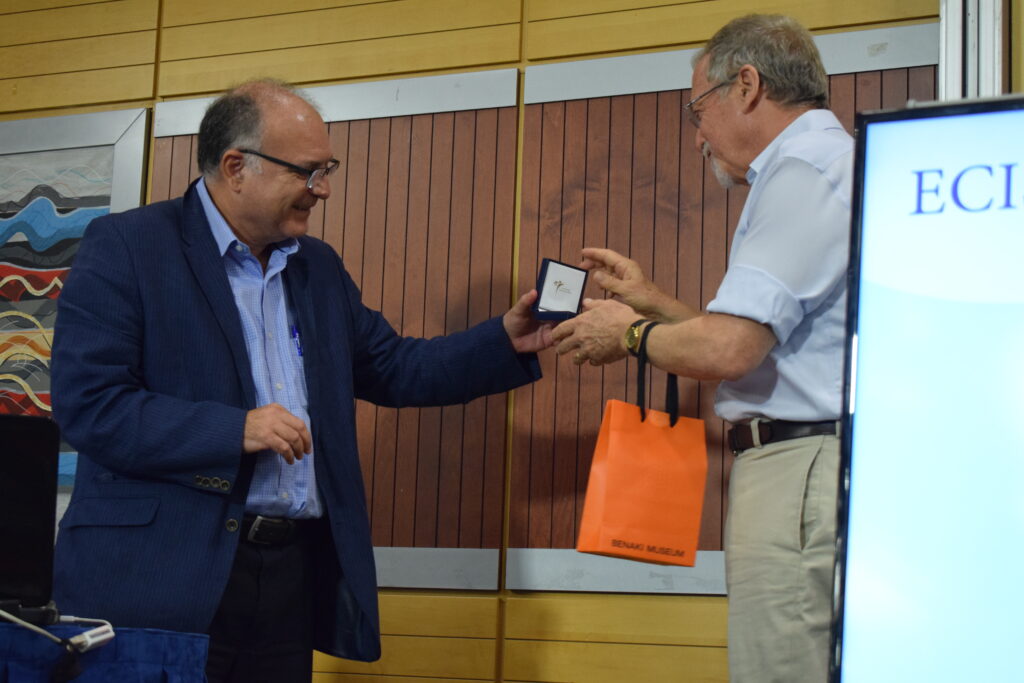
Jacob Klein (Rehovot) right with Epameinondas Leontidis
Jacob Klein is an exceptional innovative and creative researcher. His scientific achievements over more than four decades, published in over 280 papers including over 25 in Science and Nature, transformed our understanding of the behavior of soft and liquid matter at surfaces and interfaces, its modification of surface forces and its related behavior under confinement. In particular, he made pioneering contributions to understanding how surface interactions, such as those that determine colloid dispersion stability but also those that determine friction and lubrication, are modulated by polymers, by simple liquids, and especially by water and hydrated species. Five papers representative of his work are listed in the nomination form, while in this brief summary are noted several other seminal papers extending and supporting these five (full references to these can be found in Klein’s extended CV attached with this nomination).
The stability of liquid colloidal dispersions depends crucially on surface interactions of the disperse (particulate) phase. Using self-designed surface-force balances (SFBs), Klein elucidated the nature of steric and dynamic interactions at the 1 -100 nm range between polymer-bearing surfaces, which are widely used to stabilize colloidal dispersions ranging from ferrofluids to pharmaceuticals. Years before the advent of atomic force microscopy, Klein’s studies revealed directly the attractive steric forces between adsorbed polymers in a poor solvent (Nature 1980), contrasting with their stabilizing repulsion in a good solvent (Nature 1982); and especially the long-conjectured bridging attraction between polymer-adsorbed surfaces that could dominate even when the polymers themselves repelled (Nature 1984). His group subsequently (Nature 1988) determined the steric repulsion between polymer brushes, the paradigmatic structures for steric modification of surface properties. Extending his SFBs to apply shear fields and measure lateral forces with unique sensitivity and resolution, Klein demonstrated the unexpected swelling behavior of polymer brushes under shear (Nature 1991), which arises due to suppression of their excluded volume screening by lateral stretching of the chains. He also discovered (Nature 1994) the remarkable lubrication properties of polymer-brush layers, a result of the fluidity of their sheared interfacial regions arising from the weak (entropy-limited) interpenetration of the brushes. More recently (Phys. Rev. Lett. 2006, 2012) Klein and his co-workers demonstrated that two overall-neutral surfaces covered by quenched, random charge patches, experience a long-ranged attraction across water that could be orders of magnitude stronger than van der Waal’s interactions, an unsuspected consequence of the asymmetry of repulsive and attractive electrostatic double layer interactions. In related work he extended the SFB method to probe the charging dynamics of an individual nanopore, the basic element of supercapacitors (Nature Communications 2018).
Over the past two decades Klein and his co-workers elucidated the behavior under extreme confinement by surfaces of both non-polar (organic) liquids and of water, relevant to effects from flow in nanopores to lubrication. They showed that simple organic liquids confined between surfaces to films just a few (ca. 5 – 8) molecular diameters in thickness could undergo an abrupt (and reversible) liquid-to-solid dynamic phase transition (Science 1995). More recently (PNAS 2015) this was extended to show that, under lateral stress, such confinement-solidified liquids did not undergo shear melting (as was long believed) but rather experienced intra-layer slip or sliding at the confining walls. In contrast to such confinement-induced solidification of organic liquids, Klein found (Nature 2001) that water retained its fluidity down to sub-nanometer confinements, an effect arising from its phase density anomaly. He revealed (Science 2002) the phenomenon of lubrication by hydration shells only a few angstroms thick (an effect termed ‘hydration lubrication’), arising from their fluidity combined with a tenacious attachment to the enclosed charges. Recently (Nature Communications 2015a), his group was able to measure directly the (weak) viscous dissipation when such sub-nanometer shells are sheared. This fluidity of tenaciously attached hydration layers is a crucial ingredient in aqueous lubrication phenomena, as was revealed by Klein’s group for charged polymer brushes (Nature 2003), surfactants and lipids (Nature 2006, Adv. Materials 2011), zwitterionic polymers (Science 2009a), and particularly in biological lubrication (Science 2009b, Nature Communications 2015b). Extending this, just some months ago Klein and his team exploited Nature’s lipid- based strategy for reducing friction in cartilage, to create synthetic hydrogels with truly remarkable lubrication properties (Science 2020).
Klein’s contributions to surface forces and to soft and liquid matter at interfaces extend beyond the discoveries outlined above. Some 80 graduate students and postdocs were trained in Klein’s labs (at the Weizmann Institute, and at the Universities of Cambridge and of Oxford), of whom 32 are currently in tenured faculty positions in leading universities in Israel, Europe, North America and China, including several who have since achieved their own high level of distinction. In Israel, he was a pioneer in colloids and soft matter research, and was later one of the founders of the Department of Materials and Interfaces at the Weizmann Institute.
1. ‘Forces between Surfaces Bearing Terminally Anchored Polymer Chains in Good Solvents’. Taunton H. J., Toprakcioglu C., Fetters L. J., and Klein J., Nature 332, 712-714 (1988)
2. ‘Reduction of frictional forces between solid surfaces bearing polymer brushes’, Klein, J., Kumacheva, E., Mahalu, D., Perahia D. and Fetters, L.J. Nature, 370, 634 – 636 (1994)
3. ‘Fluidity of water confined to subnanometre films’ Raviv U., Laurat P., and Klein J. Nature, 413, 51-54 (2001)
4. ‘Fluidity of bound hydration layers’, Raviv U., and Klein J. Science 297, 1540-1543 (2002)
5. ‘Lubrication by charged polymers’, Raviv U., Giasson S., Kampf N., Gohy, J.-F., Jerome R., and Klein J. Nature, 425, 163-165 (2003)
